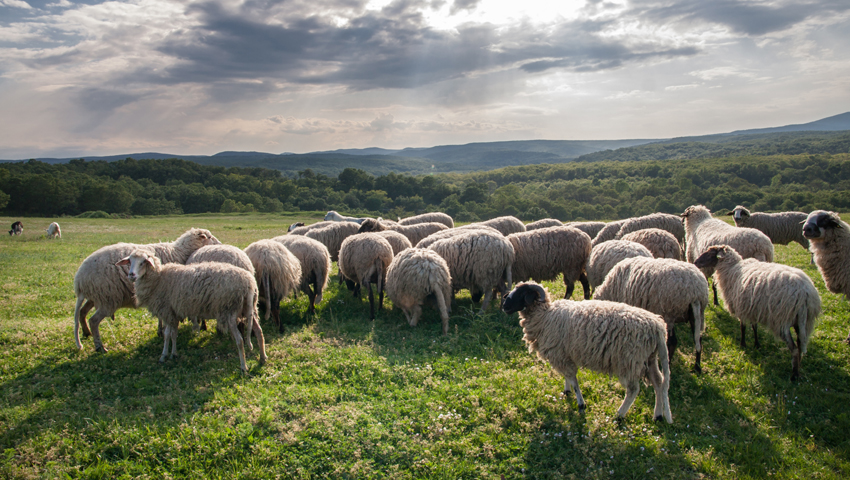Extracts from an article by Dr Natalie Meades for Business Wales, Farming Connect
There is great interest in various methane mitigation strategies, for example, programmes to breed sheep with low enteric methane emissions. Work to date has been promising and is continuing to be researched and developed. Likewise, ongoing research is being conducted to ascertain if there are any potential trade-offs associated with breeding for low methane emissions.
Ruminants have a unique digestive anatomy and physiology which comprises of a four chambered stomach consisting of the rumen, reticulum, omasum and abomasum.
The rumen is the largest chamber and can be described as a large anaerobic fermentation vat, where plant material can be degraded and fermented. This is owed to a diverse consortium of microorganisms consisting of anaerobic bacteria, methanogenic archaea, protozoa, fungi and phages which live within the rumen and are collectively known as the rumen microbiome.
These microorganisms are capable of producing enzymes that the mammalian gastrointestinal tract is incapable of producing. As such they work in synergy to degrade and ferment plant material into products that are then useful for the ruminant hosts’ metabolism. As such, the relationship between the ruminant and the microorganisms within the rumen is described as symbiotic.
This relationship allows ruminants to live on completely plant-based diets and transform plant material into highly nutritious products such as meat and milk. Moreover, this means that ruminants can consume feeds that are otherwise classified as human inedible, such as certain forages and fibrous by-products from the human food industry (distiller’s and brewer’s grains) adding to a circular economy. Moreover, ruminants can successfully graze marginal land.
It has been demonstrated that methane emissions can vary amongst individuals within flocks, with certain individuals naturally emitting less methane per kg of dry matter in comparison to others. Part of this variation is thought to be associated with genetics. Therefore, there is great interest in selecting these animals within breeding programmes.
Research in this has been conducted in New Zealand with promising results to date. A study in New Zealand conducted over a 10 year period focussed on the selection of breeding ewes based on methane yield and observed ewes regarded as low methane yielders to emit approximately 10 – 12 per cent less methane in comparison to those classified as high yielders. Likewise, another study involved the screening of sheep across New Zealand to determine high and low methane emitting individuals. Following identification of these individuals, methane breeding values were included in selection indexes and were found to reduce methane emissions by 1-2% per year of the study. Moreover, a paper reviewing various methane mitigation strategies suggested the heritability of methane emissions on an absolute emission (g CH4/ day) and yield (g CH4/ kg dry matter intake) basis to be low to moderate. Where heritability is a statistical measure of the proportion of phenotypic variability that is attributed to genetic factors.
As such it is not surprising that research associated with breeding low methane emitting sheep is currently being carried out in the UK. As part of DEFRA’s Farming Innovation Programme, £2.9 million has been awarded to the sheep sector to carry out an industry wide project delivered by Innovate called Breed for CH4nge, which aims to breed sheep with a naturally low carbon footprint and as such focus on breeding low methane emitting sheep. Likewise, Farming Connect have a support package within their programme called the Welsh Sheep Genetics Programme in which one of the focusses will be for breeding sheep with low methane emissions.
It is important, as with any breeding programme, that traits selected for are not at the expense of economically important traits. Therefore, there is ongoing research associated with this. A study conducted in New Zealand demonstrated breeding for low methane emissions was unlikely to have an effect on the prolificacy of ewes as determined through measures such as; scanning percentage, number of lambs born and lamb survival to weaning. Moreover, a study conducted in New Zealand observed selective breeding for low methane emissions within a flock to not negatively affect carcass quality or characteristics of lambs slaughtered at approximately 8 months of age.
However, studies have demonstrated sheep bred for low methane emissions to have altered digestive physiologies. A preliminary study conducted in New Zealand using CT scanning technology investigated the digestive physiologies of low and high methane yielding ewe lambs of 8 – 12 months of age. The results of the study demonstrated the low methane yielding ewes to have smaller rumens by 20% and smaller surface areas by 12% in comparison to high yielding ewes. Similar observations were also made in a study in Australia where mature low methane yielding ewes were found to have smaller rumens, shorter mean retention times of solid and liquid digesta within the rumen and fewer rumen solid contents in comparison to high methane yielding ewes. Moreover, a study conducted in New Zealand demonstrated differences in the rumen microbial communities of low and high methane yielding sheep. Therefore, the long-term implications of these factors on animal performance and productivity need to be taken into account when considering breeding for low methane emissions. As such, there is ongoing research across many research institutes into this area.
